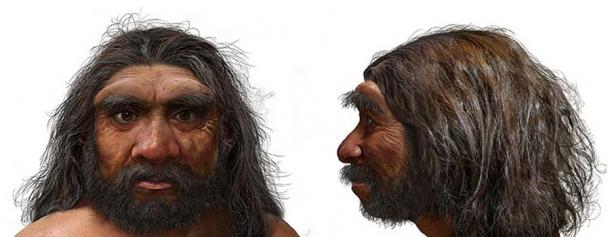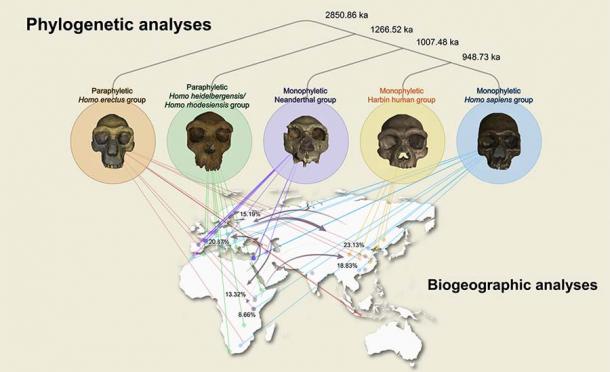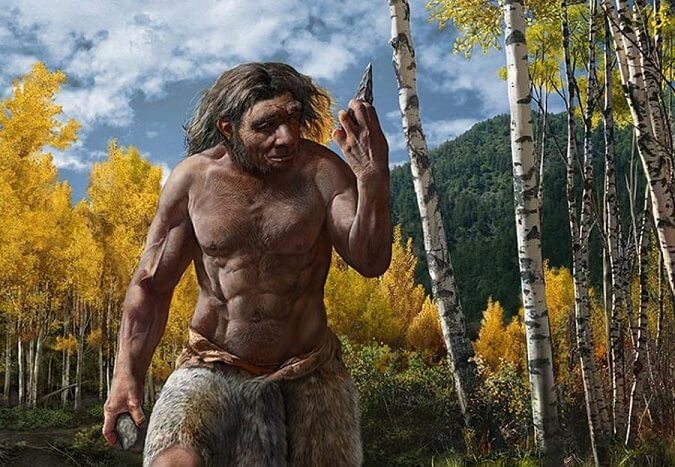‘Dragon Man’ Skull Found In China May Be ANOTHER New Human Species
Researchers in China have just announced what could be the SECOND new human species to be discovered in one week. The massive Harbin cranium seems to have a ‘mosaic’ of features leading to it being defined as a new human species.
By Nathan Falde | Ancient Origins
In the latest edition of the journal The Innovation, a team of evolutionary scientists led by Professor Qiang Ji from Hebei GEO University in Shijiazhuang, China have announced the discovery of a new human species. Their startling conclusion is based on the results of a sophisticated computer analysis of a strange human-like skull that emerged three years ago from a source in northern China.
The scientists say the Harbin skull belonged to a 50-year-old man who lived sometime between 146,000 and 296,000 years ago. This dates him to the Middle Pleistocene, or Middle Stone Age.
The skull (cranium) was intact and was most notable for its extraordinarily large size. The skull´s combination of features had never been seen before, the scientists claim, and seems to represent some type of hybrid between archaic humans and modern humans (Homo sapiens).
“The discovery of the Harbin cranium and our analyses suggest that there is a third lineage of archaic human [that] once lived in Asia, and this lineage has [a] closer relationship with H. sapiens than the Neanderthals,” said Xijun Ni, a Hebei GEO University paleoanthropologist and co-author of this new study.
Based on its huge head, the team have named their new species Homo longi, which means ‘Dragon Man’ in Chinese.

The Largest Hominin Skull Ever Found
Amazingly, the large cranium was discovered more than 80 years ago, near Harbin City in China’s Heilongjiang province. A workman found it embedded in river mud, while labouring on a construction crew building a bridge over the Songhua River in the early 1930s.
For reasons unknown, the man who discovered the skull kept its existence hidden until 2018. Only then, when he was dying, did he reveal that he had the skull and had dropped it into a well for safekeeping. After his death, his family agreed to donate the cranium to the Geoscience Museum of Hebei GEO University, where the evolutionary scientists launched their three-year investigation into its likely origins.

The standout characteristic of the skull is it size. It is the largest hominin skull ever discovered.
“This is biggest human skull I’ve seen – and I’ve seen a few,” said Chris Stringer, a paleoanthropologist from London’s Natural History Museum and human evolution expert who participated in this research project.
In comparison to a modern human cranium, there are similarities and differences. The Harbin skull has thick brow ridges and square eye sockets, like an archaic man . The cranium is also longer than that of Homo sapiens. But overall, the shape and contours of its face resemble that of an impossibly large human being. The skull’s brain cavity is also similar in size to that of a modern human.
“It’s got such an interesting combination of features,” Stringer noted. “The morphology shows that this is definitely a distinct lineage in eastern Asia. It’s not Neanderthal and it’s not Homo sapiens, it’s something quite distinctive.”
Evolutionary Analysis Reveals Surprising Results
One thing that was clear to the scientists was that the Harbin skull wouldn’t fit neatly into an already discovered species. Many of its features were familiar, but their combination was perplexing and unusual.
To find out where the Dragon Man skull belonged on the hominin evolutionary chart, the researchers used information obtained from 95 fossil crania, jawbones, and teeth, representing different hominin groups. In total they had more than 600 skull and facial features to use as points of comparison.
With this information as a baseline, they programmed a supercomputer to construct billions of theoretical evolutionary trees. When the results were in, the researchers were quite surprised to find that the computer had placed the Harbin skull on its own separate evolutionary branch. It had identified the skull as belonging to a whole new hominin species, a type of archaic man that was closely related to Homo sapiens but not identical to anything else.

“I was surprised to see this,” Stringer said. He had anticipated that the skull would be labelled as an offshoot of the Neanderthals, not as a close relative of modern humans.
To place the skull in the Middle Pleistocene, the scientists relied on results obtained from two types of advanced dating technology, X-ray fluorescence and direct uranium-series dating. These tests showed that the Dragon Man skull had to have been at least 146,000 years old.
Alternate Theories: Was the Dragon Man a Denisovan?
The announcement of the Dragon Man skull research team is being met with some degree of scepticism. It is rare to discover a new species of archaic man, and some scientists are wondering if evidence from one cranium is enough to prove the existence of Homo longi.
“Whether or not this skull is a valid species is certainly up for debate,” anthropologist Michael Petraglia, from the Max Planck Institute for the Science of Human History, told Smithsonian Magazine.
The Harbin skull is only one of many unique hominin fossils recovered from China that date to the Middle Pleistocene. The rarity of such finds raises questions about possible hidden connections.
“How do they fit in terms of their evolutionary relationships, to what degree are they interbreeding with the populations across Eurasia, and to what degree do they become isolated resulting in their distinctive features?” Petraglia asked rhetorically. “This brings up a lot of interesting questions and in human evolution China is still really a great unknown.”
Surprisingly, study participant Chris Stringer also doubts that his team has discovered a new and distinct species of ancient man. He notes some intriguing similarities between the Harbin cranium and the Dali skull, a 250,000-year-old-fossilized cranium discovered in China’s Shaanxi province. At present, Stringer believes these two skulls should be grouped together and labelled as a different species known as Homo daliensis.
One of the more fascinating suggestions is that the Harbin skull may actually belong to the mysterious Denisovans. This ancient hominin species was well-established in Asia during the Middle Pleistocene. The Denisovans were closely related to the Neanderthals and are known to have interbred with Homo sapiens (modern humans carry traces of Denisovan DNA).
Only a few Denisovan fossils have been found, none of which were intact craniums. But one recovered Denisovan jawbone had very large teeth-just like the Harbin skull.
Is this a clue that the Harbin skull may be giving scientists their first-ever look at the true face of the Denisovans? As of now, that is not the official conclusion. But as the number of fossilized remains recovered in China increases, new relationships between archaic human species may be observed and theories may change dramatically as a result.
This article (Dragon Man’ Skull Found in China May Be ANOTHER New Human Species) was originally published on Ancient Origins and is published under a Creative Commons license.

